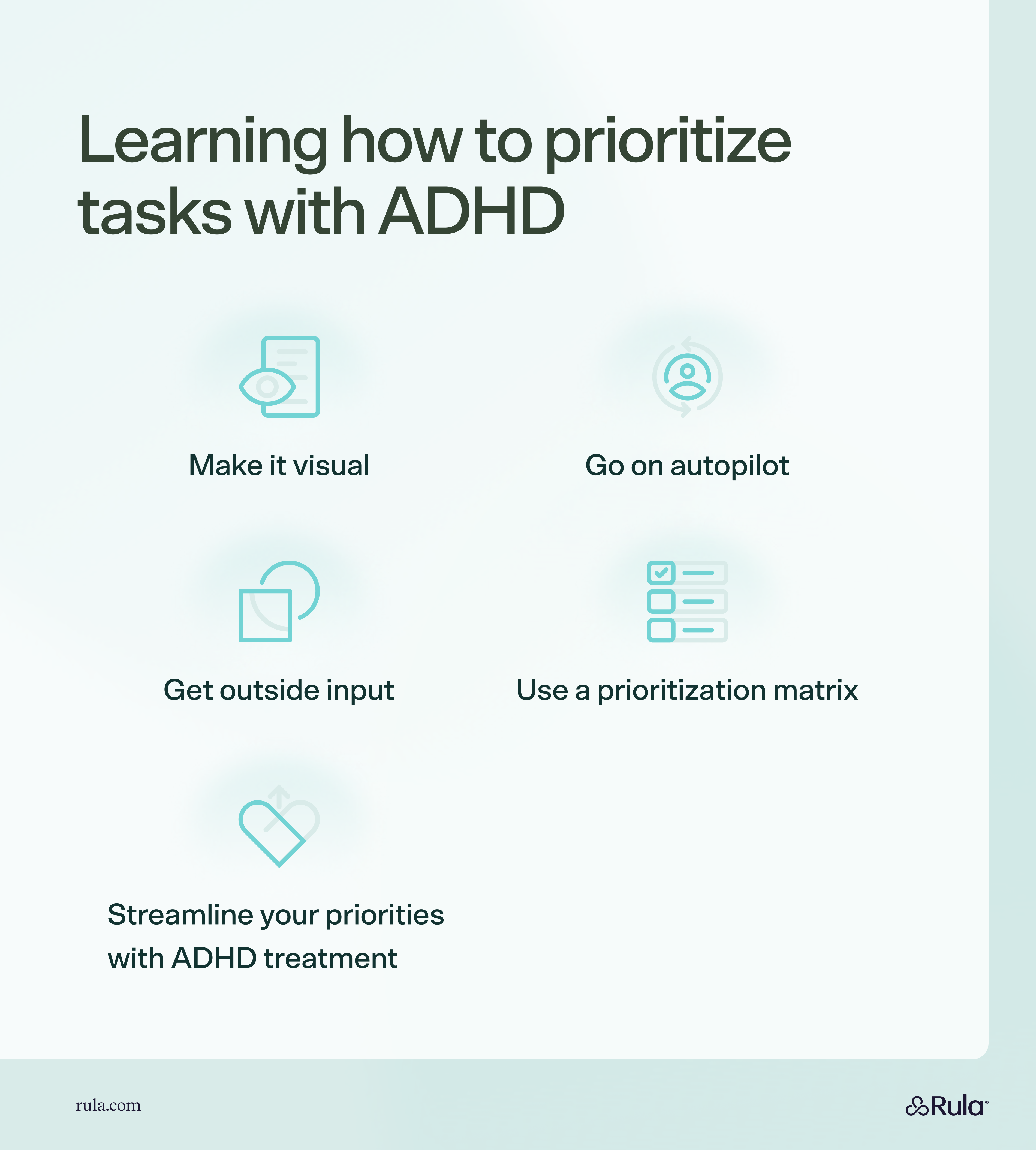By Saya Des Marais
If you live with attention-deficit hyperactivity disorder, or ADHD, you know firsthand how this condition affects your brain. One of the biggest impacts is the way ADHD can make it difficult to organize tasks.
Many people with ADHD report having a hard time prioritizing, which can sometimes lead to paralysis and overwhelm. You might not know which tasks to start with, or you might prefer to cross the more engaging tasks off your list first, leaving the “boring” but urgent tasks to pile up.

Rula provides several strategies that can provide you with step-by-step instructions on how, exactly, to prioritize tasks. But keep in mind that getting treatment for ADHD is the best way to deal with this and other effects.
Key Takeaways
- ADHD can cause executive functioning deficits, one of which is a difficulty with organization and prioritizing.
- If you have ADHD, you may have a hard time prioritizing your to-do list. You might sometimes procrastinate on urgent but boring tasks in favor of more engaging ones.
- Using organizational skills, like a prioritization matrix, can help—but it’s also essential to get effective ADHD treatment.
Does ADHD Cause Trouble Prioritizing?
Research shows that people with ADHD are more likely to have a hard time prioritizing tasks. For example, in one study, participants with ADHD described not knowing what to do or in what order to complete tasks at work, which caused problems for both themselves and other employees.
If you live with ADHD, you may freeze up when you look at your looming to-do list—a phenomenon known as ADHD paralysis. This could happen not only because you have a hard time motivating yourself but also because you become overwhelmed with trying to prioritize your list of tasks to begin with.
In other words, if you live with ADHD, it may be difficult for you to understand where to start and in what order to complete the tasks. And when every task on your list feels equally important, it’s easy to feel completely overwhelmed and shut down.
In addition, many people with ADHD have a tendency to procrastinate. This isn’t a sign of laziness but rather an outcome of what it’s like to live with an ADHD brain. You might find yourself procrastinating boring but important and urgent tasks and, instead, completing more engaging, low-priority tasks. For example, you might do the laundry instead of filing your taxes. Or walk your dog instead of finishing a complex work project.
Why Do People With ADHD Procrastinate?
ADHD can cause difficulty with task prioritization because of the way it affects your brain. Research shows that ADHD impacts the prefrontal cortex, which means it can lead to problems with executive functioning skills. These are complex cognitive skills that include:
- Problem solving
- Judgment
- Impulse control
- Organization
- Time management
- Intrinsic motivation
- Focus
All of these skills play a role in task prioritization. For example, you need judgment and problem-solving skills to be able to make wise decisions about which tasks are more urgent. You need to be able to predict how much time each task will take. And, importantly, you need to be able to practice impulse control and motivation and start tedious but high-priority tasks instead of more engaging activities. This can be difficult to do when you live with ADHD.
![]()

Learning How to Prioritize Tasks With ADHD
Prioritizing your to-do list when you live with ADHD can be challenging, but these strategies can help.
1. Make it visual
Many people with ADHD find it helpful to make task lists visual to help them analyze which items are most important. You can use whatever visualization strategy works for you, including ideas like:
- Creating a large poster of tasks
- Color-coding tasks depending on importance or deadline
- Using visual timers to measure the time each task takes
It can be easier to prioritize tasks when you have them laid out visually in front of you rather than trying to figure it out mentally. Visual reminders can also help with forgetfulness because you may find it easier to stay on track when there’s a visual cue to do so.
One systematic review found that visual activity schedules were effective in helping children with ADHD improve their social and independent skills and stay on task.
2. Go on autopilot
Part of the reason you may have difficulty completing high-priority tasks first could be because the steps needed to complete them are uncertain. You don’t know exactly how much time it will take or what steps you’ll need to go through to finish the task.
On the other hand, some lower-priority tasks on your list might feel more automatic and, therefore, easier. For example, you have done laundry a thousand times, so you know exactly what that task entails.
One way to approach task prioritization when you have ADHD is to automate every task as much as possible. Try to break each task down into smaller steps that feel more second nature and manageable to you. Make yourself step-by-step instructions for each task to make it easier for you to complete without even thinking about it.
For example, if you need to file your taxes, start by giving yourself 30 minutes to find a local tax person and make an appointment with them. Then, give yourself 20 minutes each day to compile documents from a checklist before the appointment.
When every task feels automatic, you may be less likely to procrastinate on more complex, high-priority tasks. In the study mentioned above, employees who had explicit routines and consistent implementation were more likely to perform well, even with ADHD.
3. Get outside input
Sometimes, problems with judgment and problem solving can make it difficult to differentiate which tasks are higher priority. It’s not that you’re procrastinating on higher-priority tasks— it’s that you didn’t realize that other tasks were more urgent than what you’re doing now.
It can sometimes help to get an outside perspective to help you with prioritization instead of trying to guess. Remember that ADHD affects your brain, and this isn’t anything to be ashamed about. It’s OK to ask for support. Plus, help with prioritization could be considered a reasonable accommodation at school or work, which you have a legal right to under the Americans with Disabilities Act.
For example, you could ask your manager or professor to provide you with tasks in order of urgency rather than sporadically assigning you projects over time. And if it’s within your means, getting a virtual assistant to prioritize your tasks for you can be an excellent investment. You can also ask loved ones to support you. For example, when they ask you to do something, you could ask them to rate how urgent it is.
4. Use a prioritization matrix
Prioritization or decision matrices are tools that can help anyone, with or without ADHD, with prioritizing tasks. It gives you a clear-cut way to label tasks as high, medium, or low priority. This lifts the need to figure everything out on your own and gives you a simple way to organize your to-do list.
One popular decision matrix is the Eisenhower Matrix, popularized by Stephen Covey, author of “The 7 Habits of Highly Effective People.” To use the Eisenhower Matrix, you only need to differentiate between urgency and importance.
Urgent tasks are tasks that demand your attention immediately. They may not be important to you personally, but the consequences will be significant if you don’t attend to them. These can be things like:
- Responding to emails from managers
- Meeting a last-minute deadline
- Going to the doctor when you or your child is feeling very ill
Important tasks are more subjective. They’re things that are important to you and are aligned with your values and goals. For example:
- Spending time with friends
- Engaging in hobbies
- Going back to school
- Practicing meditation
The Eisenhower Matrix guidelines go like this:
- Quadrant 1: If it’s urgent and important, do it yourself as soon as possible. This should be your first priority.
- Quadrant 2: If it’s urgent but not important, try to delegate the task if possible. If not, get it done as soon as possible.
- Quadrant 3: If it’s important but not urgent, schedule a time for you to do it in the near future.
- If it’s neither important nor urgent, take it off your list. Try to spend minimal, if any, time on these tasks. Examples include busy work or scrolling social media.
Keep in mind that spending too much of your time with Quadrant 2 tasks (urgent tasks that aren’t important to you) can result in ADHD overwhelm. So it’s important to fill your life with tasks that are important to you—without neglecting urgent tasks.
5. Streamline your priorities with ADHD treatment
Although these strategies can help, the best way to deal with difficulties with prioritizing is to get treatment for ADHD. Difficulty with prioritization is a direct result of ADHD symptoms. It may not be something you can simply “willpower” your way out of. You aren’t lazy, and difficulty prioritizing isn’t a personality defect.
Research shows that cognitive behavioral therapy strategies, including skills training groups, can help with prioritization and organization.
If you live with ADHD, you may need clear instructions on how to prioritize tasks—something that you may have never been taught because of the assumption that it’s “basic” knowledge. Skills training can provide you with specific strategies that you can implement to organize and prioritize your tasks.
On top of skills training, effective ADHD treatment in general—which typically involves a combination of medication and therapy—can help you continue using these strategies and reduce the challenges that ADHD may cause in your life.
Some research suggests that people with ADHD can have difficulties with organization even after learning skills because they don’t apply them consistently. So a therapist can help you stay on track and keep practicing new skills you’ve gained without becoming frustrated or overwhelmed.
This story was produced by Rula and reviewed and distributed by Stacker.
Originally Published:





